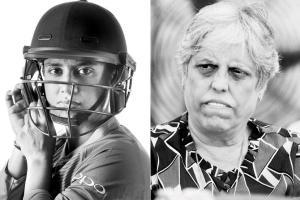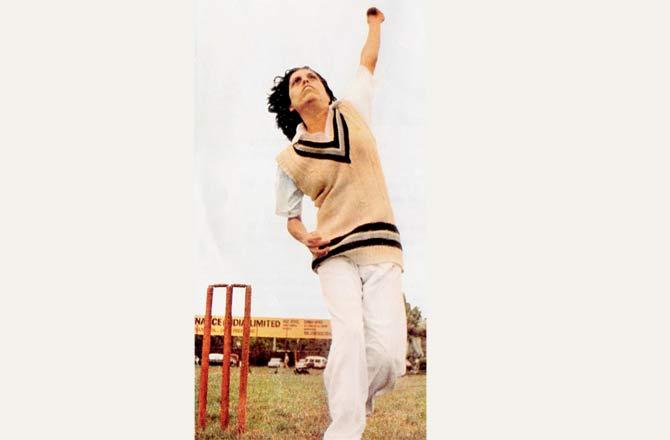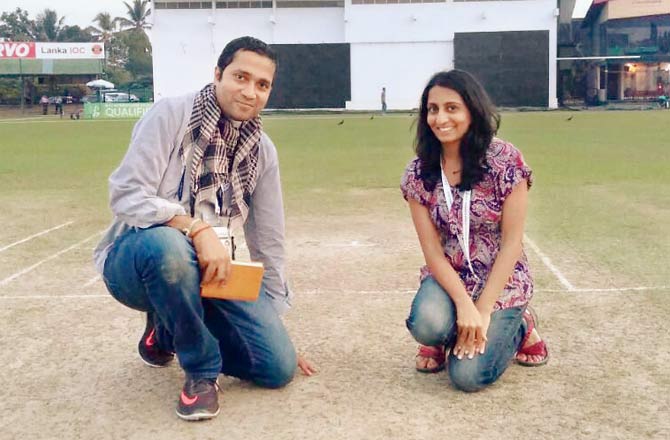Authors of two anticipated books on women's cricket in India trace Mithali Raj and Diana Fram Edulji's face-off to her last day on field when Raj's unbeaten 45 ruined Edulji's farewell

Mithali Raj and Diana Fram Edulji

Diana Fram Edulji
Last year was a defining moment in Indian women's cricket history. In the words of sports journalist Suprita Das, it was a "game-changer". "The finals [between England and India] was a sell-out, and it was simply because the quality of cricket being played was superb," she says. This year's ICC Women's World Twenty20, hosted in the West Indies, was expected to generate equal, if not more, interest, where for decades the sport had been overshadowed by the men. "Considering India made it to the World T20 semifinals for the first time in eight years, it should have been a reason to celebrate," says Bengaluru-based sports writer Sidhanta Patnaik. Karunya Keshav, another sports journalist, adds, "But then again, Indian women's cricket has always ridden the waves, so it was not inconceivable that it would again face a challenge."
It is purely coincidental then, that Patnaik and Keshav's book, The Fire Burns Blue (Westland Sport), and Das's Free Hit (Harper Sport) — both first-of-their-kind books to retrace the history of women's cricket in India — come at a time when the sport is in hot water, following cricketer Mithali Raj's unceremonious exclusion from the playing XI in the semifinals.

Suprita Das
What followed is the shocking leak of Raj's letter to BCCI CEO Rahul Johri and general manager Saba Karim, in which she spoke of the humiliation she faced at the hands of coach Ramesh Powar and the bias harboured by former cricketer and Committee of Administrators (COA) member Diana Fram Edulji. Powar, not one to hold back, responded by describing the senior player as irresponsible, a blackmailer and one who "batted only for milestones". The mud-slinging aside, the history of women's cricket in India and its rise to glory is still a compelling one. The names that stand out are that of Edulji and Raj, both players from different eras, who despite being at the heart of the current controversy, played a significant role in building an A team.
Team Diana; team Mithali
Edulji's name crops up early, as member of the Albees club, and then as captain of Bombay in the '70s. She later became one of the key contributors to international cricket along with Shantha Rangaswamy. Patnaik and Keshav discuss how Edulji's "talent had been nurtured at Badhwar Park, a railway station-turned-railway quarters in South Bombay, where her father, an employee with Western Railways, had been allotted a home".

Sidhanta Patnaik and Karunya Keshav
Delhi-based Das, who interviewed Edulji, reveals that every Sunday, the tomboy played tennis-ball cricket with the colony boys and lost her front teeth in one of the matches, when trying to smash a fast ball. When Bombay lost to West Bengal in the women's cricket national championships semifinals in 1973-74 in Varanasi, Edulji and her sulking team sprung up with the mischievous plan of pouring cough syrup on the white uniforms of Bengal's players, a day before their finals with Karnataka.
"Diana hates losing. No player likes losing, of course, and cricket is full of competitive personalities. But while others may deal with it, Diana finds it simply unacceptable," Patnaik and Keshav write in the book. They go on to describe an episode from this year when Edulji was enraged because India lost their second T20 International in a row. "She has always been an in-your-face kind of a person, and never hesitates to call a spade a spade. It's because of her feisty and go-getter attitude that Railways was able to build such a strong team that continues to dominate the domestic circuit even almost two decades after her retirement. Diplomacy is not Diana's strength, but she has lived by her strengths," says Patnaik.

Mithali Raj. Pic/Getty Images
Raj, on the other hand, got into cricket serendipitously. Born into an orthodox Tamilian family, her father Dorai Raj, an Indian Air Force sergeant, got his daughter, a Bharatanatyam dancer, into the sport, simply to get his "lazy girl" to adopt a more disciplined lifestyle. She turned out to be one of the finest batswomen the country could get, breaking one record after another: she is the highest run-scorer in international cricket. Das describes her as "intense and very hardworking". Keshav calls her "a fantastic ambassador" for the sport. "For the longest time, the era of Mithali and Jhulan Goswami was about growing women's cricket, and much of what they did was aimed at that, at leaving the game in a better place than when they got in. For young girls in the sport, they're massive role models, with their skill and work ethic."
Two players, one goal
Raj and Edulji's final face-off on the ground as cricketers for Air India and the Railways respectively did not have a happy ending. April 8, 2000, would have been Edulji's last day as a cricketer. But, Mithali's unbeaten 45 and partnership of 65 with Sunaina Mehan held the innings together for Air India, ruining Edulji's farewell. Raj went on to join the Railways.
In The Fire Burns Blue, the writers draw comparisons between the two players. "Diana and Mithali are very different personalities. Neither shirks from stating an unpopular opinion, but Diana is more combative. Their styles were what the team needed in their respective captaincy tenures," they write. Speaking about it now, Keshav says, "The Indian team has been a reflection of the Railways. So it mattered in whose style the Railways team was functioning. The two also share an obsession with being the best. The different approaches to a common cause was interesting to us."
Having said that, none of the authors can fathom why Raj was not included in the World T20 semifinal against England. "It was a tactical error," says Patnaik. "She has every right to express her views on the matter and she did it with faith in BCCI's CEO and GM. But the way it was leaked to the media by BCCI was ugly. It looked like she was being used as a pawn in the bigger politics."
When Raj wrote of Edulji's "brazen support" in the press with regard to the decision of her benching as distressing, what it did was challenge the godmother-like role that the latter had come to hold in cricketing circles. Das says, "The players I interviewed across generations, have complained about biases in team selection. This is a massive problem in women's cricket, because the volume of professional cricket they play is far lesser than men. Raj's issue is not the first instance where worthy players have been made to sit back. Anjum Chopra has been unceremoniously dropped more than once in her career." Personal politics, egos and lack of communication are reasons it has only gotten worse, she says. "Diana has always been a hard taskmaster, and that's good for cricket. But, her role as a member of the CoA, as well as that of other management members, needs to be examined thoroughly."
Patnaik says the present controversy reminds him of how former coach Greg Chappell's email to BCCI on his views about Sourav Ganguly had been leaked. "The problem facing our system is lack of accountability. Most of the decision-makers in sports bodies hold honorary positions, and do not always have the interest of the game in their heart."
In all this, the authors think, women's cricket, which is slowly gaining traction, must not suffer. It was only three years ago that the BCCI started awarding fixed contracts to its female cricketers. "It is difficult to predict a bright future even though many youngsters like Jemimah Rodrigues and Deepti Sharma are starting to make a mark. They need more opportunities as do those playing at state-level," Patnaik says. The BCCI, he says, needs to populate the domestic calendar with more tournaments for women, or else good talent will continue to fall through the cracks. "In men's cricket, India can afford to lose talent because the supply is in abundance. The case is not the same with women's cricket," he says.
Catch up on all the latest Mumbai news, crime news, current affairs, and also a complete guide on Mumbai from food to things to do and events across the city here. Also download the new mid-day Android and iOS apps to get latest updates
 Subscribe today by clicking the link and stay updated with the latest news!" Click here!
Subscribe today by clicking the link and stay updated with the latest news!" Click here!









